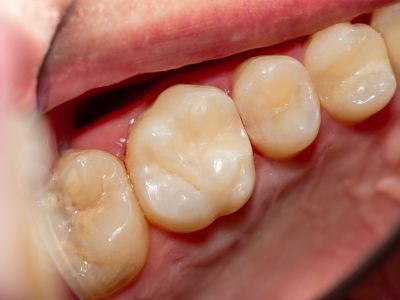Dental Restorations Part 4: Composite

In the newest generation of technology, the resin-based composite exists, which has replaced traditional amalgam and gold direct restorations in many cases, primarily due to it's tooth-colored appearance. A composite has an acrylic matrix filled with various materials which can include glass, ceramics, and other acrylic particles. This allows for the lifelike appearance. Multiple composite variations in composite design now exist, including resin modified glass ionomers (RMGIs) and giomers. Because of their more limited use, I will limit the discussion to the more common resin-based composites.
The primary indication for tooth-colored composites is to achieve a tooth-colored result, and to be able to place a filling that in some cases can be smaller than metal alternatives. Originally, composites were limited to use in front teeth, because earlier designs were not able to withstand chewing forces in back teeth. This was still a massive improvement, because front teeth had otherwise required a crown with white ceramic to achieve a tooth-colored result.
For the more forceful chewing teeth in the back of the mouth, amalgam and gold restorations remain the strongest choice. However, as time has gone by, innovation has led to composites being possible in almost any area. With trends today directing towards tooth-colored restorations, it is important to remember that front teeth are important for esthetics, while back teeth are important for function, and the location of the tooth can influence the lifespan of composites. Overall, composites are affected by more things in the mouth and prone to more complications than highly durable metal alternatives.
Composite restorations require meticulous conditions to be placed and maintained. While placing a composite, a dentist has to keep the tooth very clean and dry while working. They place a cleaning agent to further cleanse the tooth, then a priming agent to make the tooth compatible with a composite, then a glue that will bond the composite to the tooth. If any saliva contaminates the site while this process is happening, it can drastically shorten the lifespan of the composite. With different abilities to keep the tooth saliva free while in the mouth, these restorations can have a broad variation in how long they last.
An additional factor that affects composite lifespan in comparison to metal alternatives is the way they are held in the tooth: by bonding ( a "glue"), rather than physical retention with a particular shape, as is the case with metal. This means composites can only last as long as the bond/glue does. Composites also shrink a small amount once set. If placed in too large a bulk, the shrinkage will be greater and exert more stress on the tooth and the bond. When the tooth naturally flexes during function, additional stresses are applied to the bond/glue that hold them in, and they can disconnect from the tooth. Additionally, a sticky, thin film forms on the outer layer of a composite after it hardens. This layer usually can be polished away, or prevented with a surface covering. If not removed, it leads to an inferior connection to the outside of the tooth, resulting in future leakage, staining, and early failure.
Acidity levels in the mouth also affect composites. If acid is present, such as from citrus juices, coffee, stomach acid/reflux, or acid from plaque, the bond and the outer surface of the composite will deteriorate. Acidity also makes the composite porous, and increasingly prone to swelling. These factors can cause the composite's lifespan to shorten.
Small, shallow composites confined to the outside of a tooth have the ability to last the longest. This is because the outside of a tooth is pure enamel. Enamel is a hard, non-living outside layer of the tooth. Underneath enamel, where most fillings extend, is a different hard tissue called dentin. Dentin is a living tissue that is hydrated, has extensions of the tooth's nerve, as well as fluid and enzymes. These enzymes digest the bonding agent that hold composites in place. It takes a long time, with many composites reaching 10 years of service or more, but this ultimately will cause any composite to debond, or "come unglued" and pop out of the tooth. The longest lasting bonded restorations that achieve 15 years or more tend to be those limited to the outer part of a tooth, or those on front teeth with fewer chewing forces.
The benefit of composites is they offer a tremendous amount of tooth-colored potential, while also functioning quite well, given their circumstances. The tradeoff for a white appearance in a tooth are an acceptable tradeoff to many. When it comes to the appearance of a smile and maintaining the color of natural teeth, particularly in the front of the mouth, these restorations are superior.
